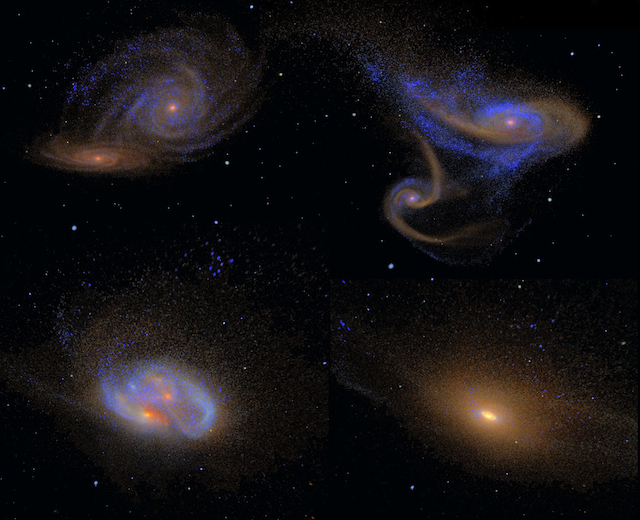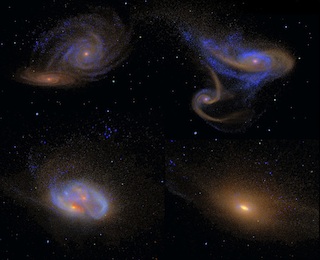view this as a PDF
ASTRONOMERS PIN DOWN GALAXY COLLISION RATES
BY COMPARING HUBBLE SPACE TELESCOPE PHOTOGRAPHS TO
SUPERCOMPUTER SIMULATIONS
Accepted for Publication in the Astrophysical Journal
A new analysis of images from the Hubble Space Telescope combined with supercomputer simulations of galaxy collisions has cleared up years of confusion about the rate at which smaller galaxies merge to form bigger ones. This paper, led by Jennifer Lotz of Space Telescope Science Institute, is about to be published in The Astrophysical Journal.
Galaxies grow mostly by acquiring small amounts of matter from their surroundings. But occasionally galaxies merge with other galaxies large or small. Collisions between big galaxies can change rotating disk galaxies like the Milky Way into featureless elliptical galaxies, in which the stars are moving every which way.
In order to understand how galaxies have grown, it is essential to measure the rate at which galaxies merge. In the past, astronomers have used two principal techniques: counting the number of close pairs of galaxies about to collide and by counting the number of galaxies that appear to be disturbed in various ways. The two techniques are analogous to trying to estimate the number of automobile accidents by counting the number of cars on a collision course versus counting the number of wrecked cars seen by the side of the road.
However, these studies have often led to discrepant results. “These different techniques probe mergers at different ‘snapshots’ in time along the merger process,” Lotz says. “Studies that looked for close pairs of galaxies that appeared ready to collide gave much lower numbers of mergers (5%) than those that searched for galaxies with disturbed shapes, evidence that they’re in smashups (25%).”
In the new work, all the previous observations were reanalyzed using a key new ingredient: highly accurate computer simulations of galaxy collisions. These simulations, which include the effects of stellar evolution and dust, show the lengths of time over which close galaxy pairs and various types of galaxy disturbances are likely to be visible. Lotz’s team accounted for a broad range of merger possibilities, from a pair of galaxies with equal masses joining together to an interaction between a giant galaxy and a puny one. The team also analyzed the effects of different orbits for the galaxies, possible collision impacts, and how the galaxies were oriented to each other.
The simulations were done by T. J. Cox (now at Carnegie Observatories in Pasadena), Patrik Jonsson (now at the Harvard-Smithsonian Center for Astrophysics in Cambridge, Massachusetts), and Joel Primack (at the University of California, Santa Cruz—UCSC), using small supercomputers at UCSC and the large Columbia supercomputer at NASA Ames Research Center. These simulations were “observed” as if through Hubble Space Telescope by Jennifer Lotz in a series of papers with Cox, Jonsson, and Primack that were published over the past three years. A key part of the analysis was a new way of measuring galaxy disturbances that was developed by Lotz, Primack, and Piero Madau in 2004. All this work was begun when Lotz was a postdoc with Primack, and Cox and Jonsson were his graduate students.
“Viewing the simulations was akin to watching a slow-motion car crash,” Lotz says. “Having an accurate value for the merger rate is critical because galactic collisions may be a key process that drives galaxy assembly, rapid star formation at early times, and the accretion of gas onto central supermassive black holes at the centers of galaxies.”
“The new paper led by Jennifer Lotz for the first time makes sense of all the previous observations, and shows that they are consistent with theoretical expectations,” says Primack. “This is a great example of how new astronomical knowledge is now emerging from a combination of observations, theory, and supercomputer simulations.” Primack now heads the University of California High-Performance AstroComputing Center (UC-HiPACC), headquartered at the University of California, Santa Cruz.
The simulated galaxy merger images have been gathered into an archive called Dusty Interacting Galaxy Gadget-Sunrise Simulations (DIGGSS, at http://archive.stsci.edu/prepds/diggss/) and placed in the Multimission Archive at STSci (MAST), the online archive otherwise used only for images from space telescopes.
This research was funded by grants from NASA and NSF, and Hubble Space Telescope and Spitzer Space Telescope Theory Grants. #####
For more information:
The paper by Lotz et al., entitled “The Major and Minor Galaxy Merger Rates at z < 1.5,” is online at http://adsabs.harvard.edu/abs/2011arXiv1108.2508L . Besides Lotz, Cox, Jonsson, and Primack, the other coauthors are Darren Croton (at Swinburne University in Melbourne, Australia), Rachel Somerville (now at Rutgers University), and Kyle Stewart (at Jet Propulsion Laboratory).
For images and more information about this study, visit: http://hubblesite.org/news/2011/30 and
http://www.nasa.gov/hubble .
For interviews, contact:
Jennifer Lotz
Space Telescope Science Institute, Baltimore, Md.
410-338-4467
lotz@stsci.edu
Prof. Joel R. Primack
Director, UC-HIPACC
Department of Physics
University of California, Santa Cruz
Santa Cruz, CA 95064
Cell: 831 345-8960
joel@ucsc.edu
Press release written by:
Trudy E. Bell, M.A.
Senior Writer, UC-HiPACC
t.e.bell@ieee.org or tebell@ucsc.edu
216-221-5008 (Eastern time)
Visualizations

Galaxy Merger - Time sequence Mosaic shows the sequence of events as two spiral galaxies like our own Milky Way merge. As the two galaxies approach (upper left), on their first close pass, they sideswipe each other, throwing out long tails of stars and gas (upper right). They then move apart before gravity pulls them back together again and their centers merge, when the stars at greater distances from the center are tossed into random orbits (lower left). Eventually the merged spiral galaxies form an elliptical galaxy (lower right).
Credits: Mosaic was made from four snapshots from high-resolution hydrodynamical simulation done at NASA Ames Research Center by Patrik Jonsson, Greg Novak, and Joel Primack using Volker Springel’s simulation code GADGET and Patrik Jonsson’s Sunrise code to visualize the effects of stellar evolution and dust scattering and absorption of light and re- radiation of the energy at longer wavelengths. Collage created by Nina McCurdy. Published as Figure 49 from Chapter 5 of Nancy Ellen Abrams and Joel R. Primack, The New Universe and the Human Future (Yale University Press, 2011) .
Having trouble viewing this? Watch it on Youtube
Merging Spiral Galaxies - simulating visual appearance. This video shows a computer simulation of the appearance of two merging spiral galaxies as they would appear through a telescope, including absorption of starlight by interstellar dust. The colors are approximately what would be perceived by the human eye. Credits: Patrik Jonsson, Greg Novak & Joel Primack, University of California, Santa Cruz.
Having trouble viewing this? Watch it on Youtube
Merging Spiral Galaxies - Narrated. In October 2009 Nancy Abrams and Joel Primack gave the Terry Lectures at Yale University, a prestigious series in science and meaning that has continued for over a century. This narrated version of the "Merging Spiral Galaxies" visualization was included in the 4-part lecture series entitled "The New Universe and the Human Future". Full recordings may be found at the following url: http://new-universe.org/TerryLectures.html
